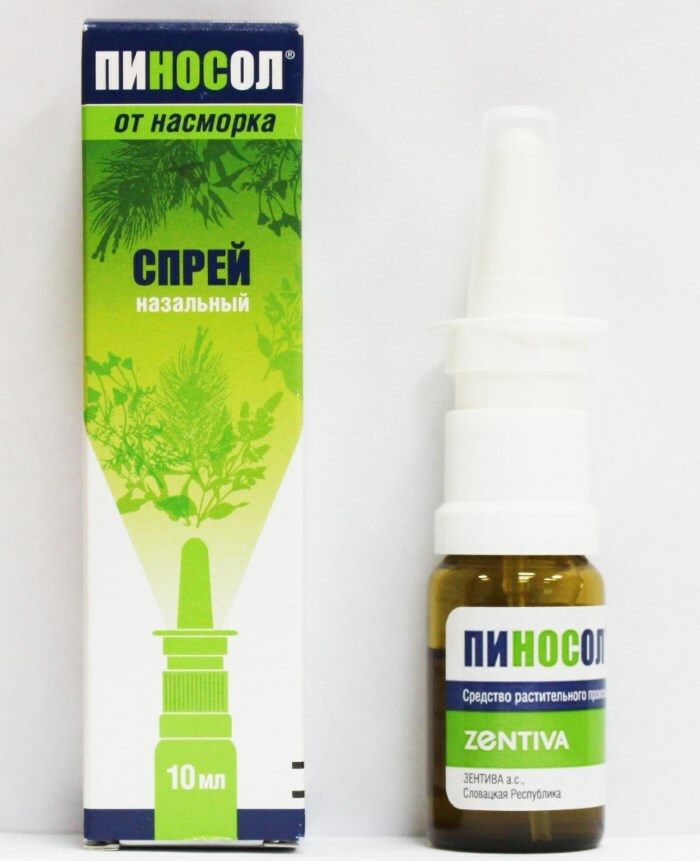Type of chestnuts includes more than a dozen different plants, and one of them was named equine. According to one version, such a name was given to him as a fodder variety, so that it would be easier for people to distinguish it from fruits that are edible to humans. This plant has many medicinal properties that have found application in both folk and official medicine.
Record content:
- 1 For medical purposes
-
2 Useful action
- 2.1 Features of the fight against diarrhea
- 2.2 Astringent properties
- 2.3 For adults
- 2.4 For children
- 2.5 For pregnant women and with hepatitis B
- 2.6 In old age
- 3 Contraindications to use
-
4 Preparation of healing compositions
- 4.1 Infusion and decoction
- 4.2 Tincture
- 4.3 Extract
- 4.4 Ointment
-
5 The use of horse chestnut
- 5.1 Diseases of veins and blood vessels
- 5.2 Respiratory tract diseases
- 5.3 Gynecological diseases
- 5.4 Diseases of the joints
- 5.5 Diarrhea and diarrhea
- 5.6 Use in cosmetology
- 6 Video about the benefits of chestnut
For medical purposes
For medicinal purposes, the properties of fruits, leaves, flowers and plant bark are used. Chestnut blooms en masse from May to June. The inflorescences are distinguished by a complex shape, on some of them large double flowers open. After flowering, fruits are formed, which are in a tricuspid prickly box with an opening tubercle.
Under natural conditions, chestnut grows naturally in the southern territories of Europe, in the northern states and regions of East Asia, and is common in North America. In Russia, the plant is found everywhere in European territory, in zones with moderate climatic conditions.
In addition, the horse chestnut is specially planted and grown. Any plants (both growing in nature and planted by humans) are melliferous, and also perform a good decorative function during the entire growing season.
Chestnut fruits, the medicinal properties and use of which have long been known, are distinguished by the presence of a large amount of useful substances. Its chemical composition is amazing.
- Chestnuts, unlike other nuts and seeds, are not too low in calories and are quite fatty. In doing so, they are a rich source of minerals, vitamins and phytonutrients that provide tremendous health benefits.
- They are mainly composed of starch (carbohydrates), unlike other types of seeds and nuts, which are quite high in calories and contain high amounts of protein and fat. The nutritional composition of chestnuts is comparable to that of other starchy foods such as sweet potatoes, sweet corn, potatoes, and so on.

Chestnut fruits. Healing properties - They are an excellent source of dietary fiber; offering 8.1g (about 21% of the RDI) per 100g. Fiber helps lower blood cholesterol levels by limiting the absorption of excess cholesterol in the intestines.
- Chestnuts differ from other edible nuts in their characteristic nutritional composition. They are very rich in vitamin C. 100 g of fruit contains 43 mg of this substance (72% of the daily dose). Vitamin C is essential for the formation of teeth, bones, and blood vessels. As a powerful antioxidant, it protects against harmful free radicals.
- Chestnuts are rich in folate at the same levels as green leafy vegetables, which is a rather rare and unique trait. 100 g contains 62 μg of this substance (or 15.5%). Folic acid is essential for red blood cell formation and DNA synthesis. Adequate intake of food rich in this trace mineral before conception helps prevent neural tube defects in the newborn.
- Like real nuts, they are also a rich source of monounsaturated fatty acids such as oleic and palmitoleic. Research shows that monounsaturated fat (MUF) in the diet can help lower overall levels cholesterol as well as the amount of LDL (bad cholesterol) and increase the content of HDL (good) in blood.
- A diet rich in fiber, MUF, omega fatty acids and antioxidants helps prevent coronary artery disease and strokes by promoting a healthy blood lipid profile.
- Chestnuts are an excellent source of minerals such as iron, calcium, magnesium, manganese, phosphorus and zinc, and they also contain very good amounts of potassium (518 mg / 100 g). Potassium counteracts the hypertensive effect of sodium, reduces heart rate and blood pressure. Iron helps prevent microcytic anemia. Magnesium and phosphorus are important components of bone metabolism.
- They are also rich in many important B vitamins. 100 g of nuts contains 11% niacin, 29% pyridoxine (vitamin B-6), 100% thiamine and 12% riboflavin.
- Chestnuts, like all nuts (hazelnuts, almonds, etc.), are gluten-free. Therefore, they are often used as a substitute for one of the popular ingredients in the preparation of gluten-free food. formulas for patients with sensitivity to this substance, wheat allergy and gluten intolerance.
| Calories and macronutrients | Quantity per 100 g | |
| Calories | 245 kcal | |
| Carbohydrates | 53.0 g | |
| Cellulose | 5.1 g | |
| Sugar | 10.6 g | |
| Fats | 2.2 g | |
| Saturated fat | 0.4 g | |
| Monounsaturated fat | 0.8 g | |
| Polyunsaturated fats | 0.9 g | |
| Omega-3 | 93.0 mg | |
| Omega-6 | 776 mg | |
| Protein | 3.2 g | |
| Vitamin | Content in 100 g | % of the daily value |
| Vitamin C | 26.0 mg | 43% |
| Vitamin B6 | 0.5 mg | 25% |
| Folate | 70.0 μg | 17% |
| Thiamine | 0.2 mg | 16% |
| Vitamin K1 | 7.8 mcg | 10% |
| Niacin | 1,3 mg | 7% |
| Pantothenic acid | 0.6 mg | 6% |
| Vitamin E | 0.5 mg | 2% |
| Vitamin A | 1 μg | 0% |
| Choline | 1.5 mg | — |
| Mineral | Content in 100 g | % of the daily value |
| Manganese | 1.2 mg | 59% |
| Copper | 0.5 mg | 25% |
| Potassium | 592 mg | 17% |
| Phosphorus | 107 mg | 11% |
| Magnesium | 33.0 mg | 8% |
| Iron | 0.9 mg | 5% |
| Zinc | 0.6 mg | 4% |
| Calcium | 29.0 mg | 3% |
| Selenium | 1.2 mcg | 2% |
| Sodium | 2.0 mg | 0% |
Due to this composition, chestnut has the following properties:
- used as a hemostatic, diuretic, wound healing, analgesic and antioxidant agent;
- effective in the treatment of edema, varicose veins and relief of inflammation, violations of the water-salt balance;
- can cope with the problems of high blood pressure and cholesterol;
- successfully used to normalize the acidity of the stomach and the work of the digestive system;
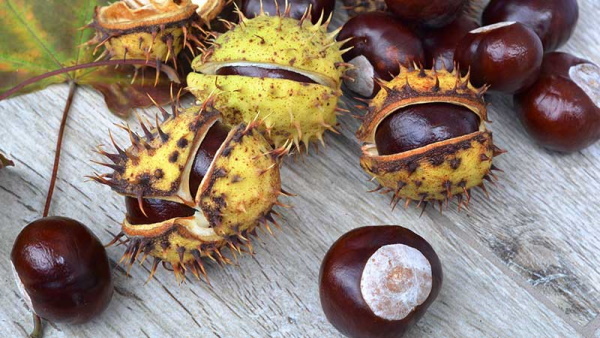
- Since the bark of the tree contains large doses of vitamin C, tannins and thiamine, various antipyretic and astringent agents are produced on its basis.
Useful action
The chemical composition of chestnuts provides excellent health benefits and supports the best functioning of the body. It has been shown to improve a defense system called immunity, and this contributes to the maintenance of good health and well-being.
Features of the fight against diarrhea
The fruit of the chestnut tree and especially the bark of the chestnut tree is a very effective remedy for diarrhea. The water in which the chestnuts were boiled together with their shell or bark is rich in tannins. These substances, when taken in controlled amounts, have a fixing effect.
Astringent properties
Chestnuts are anti-inflammatory, which makes them astringent due to their high tannin content. These substances can relieve skin problems and partially relieve swelling and pain caused by tissue damage in the body. They also promote faster wound healing and soothes the body. This property of chestnut is especially effective in the treatment of hemorrhoids.
For adults
The peel of chestnut fruits is actively used in traditional medicine to combat problems such as prostatitis and adenoma.
An alcoholic tincture is prepared from it (1 part of the crushed peel plus 10 parts of 40% or 70% alcohol is mixed and infused from 1 week to 1 month), which is taken for 20 minutes. before meals 1 time per day, at a dosage of 10 drops. To ensure a stable therapeutic effect, the agent must be taken in a long course with interruptions (3 weeks plus another 3 weeks after 10 days).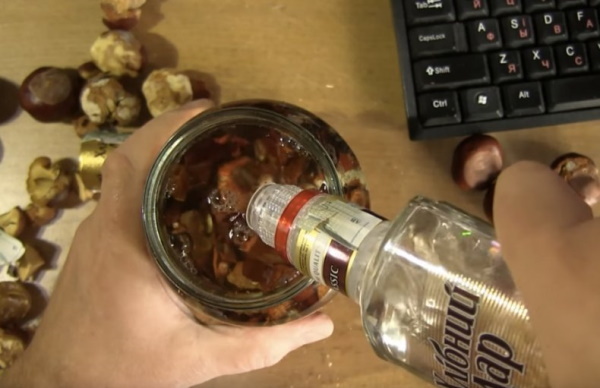
All parts of the chestnut have medicinal properties that are effective in treating some female problems. Decoctions from the fruits and flowers of the plant help in the fight against mastopathy, fibroids and uterine bleeding.
For children
Despite the fact that there is no scientific evidence about the possible dangers of chestnut for a child's body obtained, it is recommended not to use preparations based on this plant for the treatment of preschool children age.
For pregnant women and with hepatitis B
To date, no official evidence has been received that any part of the chestnut can have a harmful effect on a woman during pregnancy or on the fetus.
Doctors recommend not to use pharmaceutical preparations and folk remedies based on this plant in the first trimester of pregnancy.
In old age
To ensure the safe use of preparations from this plant, especially for the treatment of chronic diseases, it is necessary to obtain a preliminary consultation with a doctor. This is especially true for older people with acquired age-related health problems.
Contraindications to use
Horse chestnut extract can cause a number of side effects, including itching, nausea or gastrointestinal problems, muscle pain, and headache.
People with kidney or liver disease and bleeding disorders should avoid eating horse chestnut.
Preparations based on this plant should not be combined with aspirin, plavix (clopidogrel), coumadin (warfarin) and others. anticoagulants or antiplatelet (blood thinning) drugs, since the action of these medicines.
Many dietary supplements used as traditional medicines have not actually been tested for safety because they are not officially drugs. This means that the content of some products may differ from what is indicated on their labels.
Chestnuts are of a different botanical class than nuts (almonds, walnuts, and Brazil nuts), so they are very unlikely to be dangerous for people with nut allergies. However, you should still take precautions. People who are allergic to fruits and latex may have cross-reactions to chestnuts, which should also be considered.
Preparation of healing compositions
Back in the Middle Ages, raw seeds were discovered to be beneficial in treating heart disease. The leaves have been used in folk medicine as a tea in France to treat whooping cough and diarrhea.
Besides leaves, bark is also a good source of tannins. It has anti-inflammatory, expectorant, tonic and astringent effects. The latter is especially useful in the treatment of bleeding and diarrhea.
Leaf infusions are used for respiratory problems and are a common treatment for whooping cough, fever, and chills. The leaves are also used to treat rheumatism, to relieve back pain, and to relieve tension in muscles and joints. Their broth is used as a gargle to treat sore throat.
Infusion and decoction
These are the most common external remedies. They are produced from leaves and flowers, as well as from crushed fruits.  The easiest way to prepare such a preparation is to fill a deep container with plant parts, pour boiling water over and leave for 12 hours to infuse. Then the mixture is filtered and used to treat a variety of diseases.
The easiest way to prepare such a preparation is to fill a deep container with plant parts, pour boiling water over and leave for 12 hours to infuse. Then the mixture is filtered and used to treat a variety of diseases.
Tincture
Chestnut fruits, whose medicinal properties and uses are widely known, are also used as the basis for alcohol settings. These are drugs that are fairly easy to make at home. To get a positive result, you just need to purchase high-quality raw materials and observe the necessary proportions of substances when mixing.
It is noted that the tincture of the fruits of the plant has the most pronounced medicinal properties, in comparison with leaves and flowers. This drug is known as a good remedy for inflammatory diseases, manifestations of gout and rheumatism.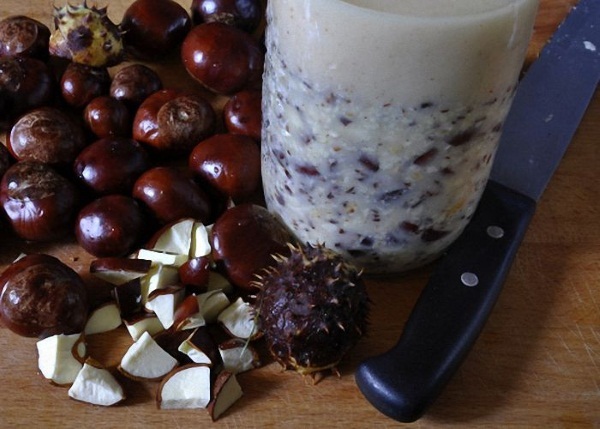
It is also used to relieve various pains. Tincture accelerates recovery in some cancers, if taken simultaneously with the main treatment.
Extract
Natural chestnut extracts are used in various oils or dairy products. The proportions in this case can be arbitrary. Such mixtures have a short shelf life (several weeks), therefore they are less popular.
Ointment
Chestnut fruits, the medicinal properties and applications of which are very numerous, can be used for the manufacture of ointments.
The easiest way to do this is:
- Grind 5 pieces of peeled plant fruit.
- Mix them with 0.5 liters of vegetable oil (the type does not matter) and process for 1 hour in a water bath.
- When the mixture has cooled, it is filtered and stored in a closed container at room temperature.
The result is a good remedy for skin and joint problems.
The use of horse chestnut
Chestnut is actively used for the manufacture of various drugs by both pharmaceutical companies and various herbalists and supporters of traditional medicine. Its bark is harvested for this purpose in late spring-early summer, fruits - in late summer-early autumn, flowers - in the season of their appearance. Chestnut leaves are suitable for harvesting and using throughout the warm season.
- The fruits of the plant are the most enriched with many useful components and trace elements. They contain little fat and significant amounts of carbohydrates and proteins. They contain about 60% fiber and are high in potassium, iron, copper, B vitamins and many other minerals.
- As with any medicinal plant, the leaves have many beneficial properties. They are used for the manufacture of drugs for the treatment of diseases of the heart and blood vessels (including varicose veins, thrombophlebitis and other inflammations and violations of vascular strength).
- Chestnut bark is especially effective in relieving gastrointestinal symptoms, including diarrhea and heartburn. Preparations based on it are used as a hemostatic agent, as well as for the treatment of bronchitis.
- Decoctions and tinctures on alcohol are made from the flowers of the plant, which are effective for the treatment of many health problems (cardiovascular diseases, liver, respiratory and joint diseases).
In addition to folk remedies, there are also pharmaceutical preparations based on parts of chestnut (tinctures, tablets, creams and drops). They have proven to be a good anti-inflammatory agent that is also effective against blood clots.
Diseases of veins and blood vessels
Chestnut fruits, the medicinal properties and applications of which are extensive, are considered the most effective means of reducing blood density and fighting blood clots. Therefore, drugs based on it are actively used to treat varicose veins, violations of the integrity of blood vessels and thrombophlebitis.
- You can prepare a tincture for these pathologies yourself: 50 g of inflorescences must be mixed with 0.5 liters of vodka, put in a dark place and wait 2 weeks, shaking the container from time to time. This remedy should be taken three times a day, 30 drops before meals for 3-4 weeks.
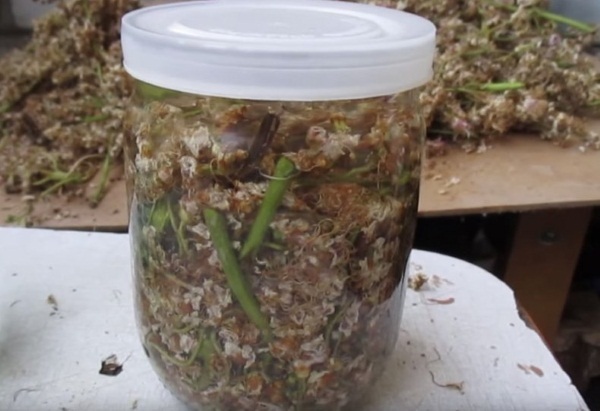
- From the peel of the fruit, a tincture is made for external use (as compresses). To do this, mix 50 g of chestnut peel and 0.5 l of vodka in a tight-fitting container and leave it in a dark room for 2 weeks, then filter.
- For the treatment of varicose veins on the legs, as well as to relieve the symptoms of hemorrhoids, you can also use freshly squeezed juice of chestnut flowers. It must be diluted with water (in a proportion of 25 drops per 1 tbsp. l.) and take twice a day.
- The flowers of the plant can also be used to make tinctures. To do this, they are mixed with vodka (in a proportion of 50 g per 0.5 l) and left in a dark place for 2 weeks. This tincture can be used both externally and internally. External use has no restrictions, and for internal use, the dosage is 30 drops three times a day, while the agent should be diluted with 1 tbsp. l. water.
- A classic tincture is also prepared from peeled chestnut fruits, which is an effective remedy for varicose veins. To do this, 20 chestnuts are finely chopped and chopped in mashed potatoes, 1 liter of vodka is poured in and left for 10 days in a dark place, after which they are filtered.
- For the treatment of hemorrhoids, it is recommended to take baths with the addition of a decoction of chestnut bark. This tool is prepared as follows: mix 50 g of dry bark and 1 liter of water, then you need to boil and cook the mixture over low heat for half an hour, then cool.
Respiratory tract diseases
A decoction of chestnut leaves is taken to treat bronchitis and the effects of tuberculosis. In addition, this remedy is also effective for alleviating the manifestations of gout, various diseases of the gastrointestinal tract and rheumatism.
Prepare it like this: you need to mix 1 tbsp. l. chestnut leaves with 0.5 liters of water and cook over low heat or in a water bath for 20 minutes, then cool. The broth should be taken before meals at a dosage of 100 g.
Gynecological diseases
The peel of the chestnut fruit has noticeable hemostatic properties. Therefore, to combat uterine bleeding, it is doused with a decoction twice a day (300 ml of water + 15 g of chestnut peel, boil on low heat for 10 minutes).
A powder is prepared from fried fruit kernels, a brewed drink from which (in a proportion of 1 tsp. l. 250 ml of hot water) helps in the treatment of uterine fibroids. The specified amount is divided into 3 doses and consumed during the day.
Dried chestnut flower tea is effective in combating mastopathy. Brew it in a ratio of 5 tbsp. l. 1 liter of water, bring to a boil and leave overnight. In the morning, you need to drink a few sips of this tea on an empty stomach.
Diseases of the joints
The medicinal properties of chestnut fruit are widely known for joint diseases. The use of various tinctures as compresses shows excellent results.
One of the most effective external remedies is prepared as follows:
- Mix 300 peeled and crushed chestnut fruits and 250 ml of pure medical alcohol.

- Place the mixture in a glass container with a tight-fitting lid and leave in a dark place for a week.
- For use, it is necessary to soak a natural fabric with tincture and fix it on a sore spot for 1 hour.
Diarrhea and diarrhea
For the treatment of diarrhea, a decoction of chestnut bark or unpeeled fruits is used. To cook it, you need to mix 3 tbsp. l. raw materials and 1 liter of water, boil and cook for about 20 minutes. over low heat. The broth is taken in pure form, up to 2-3 tbsp. in a day.
Use in cosmetology
The fruits and other parts of the chestnut are used not only for the manufacture of medicines. Since the plant has extensive useful and medicinal qualities, it began to be actively studied and used in cosmetology.
Currently, many plant-based care products are produced that have pronounced anti-aging properties (creams and face masks). On the market you can find hair masks that improve their structure with regular use.
Video about the benefits of chestnut
About horse chestnut:


